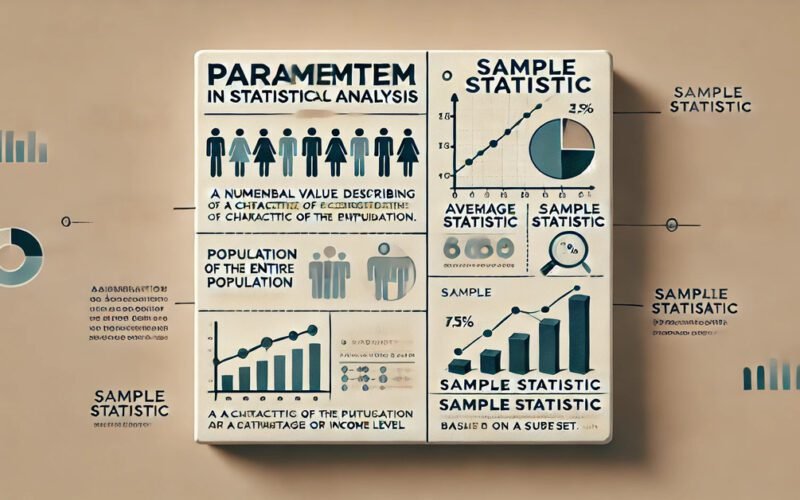Summary: Parameters are critical in statistical analysis, offering a true measure of population characteristics. Understanding their estimation and role allows researchers to make informed decisions and accurately interpret data.
Introduction
In statistical analysis, a parameter represents a specific numerical value that describes a characteristic of an entire population, such as the average age or income level. Unlike sample statistics, which provide insights based on a subset of data, parameters offer a complete view by summaris ing the entire dataset.
This blog aims to clarify what parameters are, explain their role in accurately representing populations, and discuss their importance in drawing meaningful conclusions. By understanding parameters, you’ll gain insight into how statisticians make data-driven decisions and how parameters differ from other metrics in statistical studies.
Learn about five key statistical Data Analysis techniques with real-world examples
Key Takeaways
- It provide a true representation of population characteristics, which is essential for accurate analysis.
- Estimating parameters through methods like MLE enhances data-driven decision-making.
- Understanding the difference between parameters and statistics is crucial for effective statistical interpretation.
Understanding Parameters in Statistics
In statistical analysis, a parameter is a value that represents a specific characteristic of an entire population. Unlike a statistic, which describes a sample or subset of data, a parameter reflects the true measure of a population’s attribute.
Since it is often impractical to survey an entire population, parameters serve as the “true” values that analysts aim to estimate through samples.
Importance of Parameters in Drawing Conclusions About a Population
Parameters are crucial in statistical analysis as they allow us to draw accurate conclusions about a population. Researchers can make informed predictions and generalisations When they use sample data to infer these population parameters.
For example, knowing a country’s population’s mean income (a parameter) helps economists set realistic policies and financial forecasts. Parameters thus serve as the foundation for hypothesis testing, predictive modelling, and decision-making. By estimating population parameters accurately, analysts and researchers gain insights for developing strategies, assessing trends, and making data-driven decisions across various fields.
Types of Parameters in Statistical Analysis
Let’s explore the key parameters commonly used in statistical analysis, from measures of central tendency like mean and median to variability and distribution such as variance, standard deviation, proportions, and percentiles.
Mean (μ)
The mean, often symbolised by μ, represents the average value of a data set and is one of the most widely used parameters in statistics. To calculate the mean, sum all the values in a population and divide by the total number of values.
For example, if a researcher surveys 100 people on their daily screen time, the mean would be calculated by adding all the hours and dividing by 100. The mean is highly informative, especially when data points are evenly distributed, as it reflects the general trend within the population.
However, it may not be as accurate when outliers are present, as extreme values can skew the mean, making it less representative of the central tendency.
Median
The median is the middle value in a sorted data set and is used as a parameter when the data distribution is skewed. Unlike the mean, the median provides a better measure of central tendency when data has outliers or is asymmetrically distributed.
To find the median, organise all values in ascending order; the median is the central value if there is an odd number of values or the average of the two middle values if there is an even number.
For example, in household income data, where high-income outliers can skew the mean, the median accurately represents the typical income within the population. This parameter is especially useful in economics and social sciences, where data distributions are often skewed.
Variance (σ²) and Standard Deviation (σ)
Variance (σ²) and standard deviation (σ) measure data spread or variability within a population. Variance indicates the average squared deviation from the mean. In contrast, the standard deviation is the square root of the variance, bringing the measure back to the same unit as the data points.
For example, if two classes have the same mean score but different variances, the class with a higher variance has more spread out scores, while the class with a lower variance scores closer to the mean.
Standard deviation is widely used in various applications, such as quality control and risk assessment because it provides insight into consistency and predictability within a data set. Low standard deviation suggests that most values cluster around the mean, while high standard deviation indicates a broader spread.
Proportion (p)
The proportion parameter, represented as p, measures the fraction or percentage of a population that falls within a particular category. It is most commonly used in categorical Data Analysis, where individuals or items are divided into distinct groups.
For instance, in a survey of 1,000 voters, if 600 favour a particular candidate, the proportion supporting that candidate is 600/1000 or 0.6 (60%). Proportions are critical in fields like public health, polling, and market research, where understanding the prevalence of specific characteristics or preferences is essential.
Percentiles and Quartiles
Percentiles and quartiles divide data into sections, showing the relative standing of values within a population. A percentile indicates the percentage of data points that fall below a certain value, while quartiles divide data into four equal parts.
For example, in test scores, if a student’s score is at the 75th percentile, they performed better than 75% of the population. Quartiles, including the first quartile (Q1), median (Q2), and third quartile (Q3), are frequently used in income studies, school rankings, and customer satisfaction surveys.
These parameters offer valuable insights into data distribution and help identify outliers and patterns, which are useful for comparative analysis and decision-making.
Do you know about the types and components of statistical modelling?
Role of Parameters in Hypothesis Testing
Hypothesis testing uses parameters to provide a structured way to determine whether there is enough evidence to support a particular claim about a population. This section explores the importance of parameters in hypothesis testing, explains the process, and illustrates how parameters allow us to draw meaningful conclusions about population characteristics.
Explanation of Hypothesis Testing and Its Reliance on Population Parameters
Hypothesis testing involves evaluating whether a statement about a population parameter, like the mean (μ) or proportion (p), is likely to be true based on sample data.
Typically, hypothesis testing starts with setting a null hypothesis (H₀), a default statement asserting no effect or difference in the population. The test also includes an alternative hypothesis (H₁), representing the effect or difference researchers expect to find.
Parameters guide the hypothesis testing process by defining these hypotheses and providing a baseline for comparison. Researchers can measure the likelihood of observing their sample data if the null hypothesis is true by calculating sample statistics and comparing them to hypothesised population parameters.
How Parameters are Used to Make Inferences about Population Characteristics
Once a hypothesis test is conducted, parameters help determine whether the findings are statistically significant. Statistical tests use parameters to calculate a test statistic, such as a z-score or t-score, which quantifies the degree of deviation from the hypothesised parameter. This score then determines a p-value, helping researchers decide whether to reject the null hypothesis.
When parameters align closely with sample estimates, researchers may conclude that their results represent the entire population. Conversely, significant deviations indicate that the alternative hypothesis may be true. Hypothesis testing allows researchers to make valid inferences about population characteristics by relying on parameters, ultimately supporting data-driven decisions in various fields.
Discover the different types of Data Analysis
Estimating Parameters
Various methods are available to estimate parameters, each suitable for specific types of data and analysis. Here, we’ll explore some common methods, the differences between point and interval estimates, and real-world applications.
Methods of Parameter Estimation
The Maximum Likelihood Estimation (MLE) and the Method of Moments are widely used parameter estimation techniques. MLE seeks parameter values that maximise the likelihood of the observed data, making it particularly useful when working with large datasets.
This approach is robust and efficient, especially in applications that require precise probabilities, such as genetics and machine learning.
The Method of Moments, on the other hand, estimates parameters by equating sample moments to population moments. This approach is often simpler than MLE and can be advantageous when MLE is computationally intensive. The Method of Moments is popular in econometrics and finance, where analysts often estimate parameters based on limited sample data.
Point Estimates vs. Interval Estimates
Point estimates provide a single best guess of a population parameter based on sample data. While useful, point estimates lack information about the accuracy or reliability of the estimate.
Interval estimates, like confidence intervals, address this limitation by providing a range within which the true parameter value is likely to fall. For instance, instead of estimating a population mean as precisely 50, an interval estimate might suggest it lies between 45 and 55, offering greater context and reliability.
To also learn about regression analysis in statistics.
Parameters vs. Statistics
Understanding the distinction between parameters and statistics is fundamental to accurate data interpretation in statistical analysis. While both play critical roles, they serve different purposes depending on the scope of the analysis.
Defining Parameters and Statistics
It represent numerical values that describe a characteristic of an entire population. These values, such as the mean (μ), variance (σ²), or proportion (p), are constants for a given population and do not change unless the population changes.
They are challenging to determine directly, especially for large populations, as gathering data from every member can be impractical.
On the other hand, statistics measures derived from a sample—a population subset. Common examples include the sample mean (x̄), sample variance (s²), and sample proportion (p̂). Unlike parameters, statistics are variable; they change depending on the sample chosen from the population. By using sample statistics, researchers make inferences about the population parameters.
When to Use Parameters Over Statistics
It preferred when precise and complete population data is available, allowing for exact measurement without estimation. For example, a census providing data on every citizen allows analysts to use parameters directly, giving accurate demographic insights.
When Statistics are More Useful
Statistics are ideal when population data is unavailable or difficult to obtain, as collecting a representative sample can still offer valuable insights. For instance, studying a sample group in medical research enables scientists to infer health trends without surveying the entire population. Here, sample statistics are reliable estimates, making data collection more feasible and efficient.
Here are some more crucial blogs related to statistics:
Statistical Tools for Data-Driven Research.
An Introduction to Statistical Inference.
Common Misconceptions about Parameters in Statistical Analysis
Misunderstandings about parameters are common, especially when distinguishing them from statistics or interpreting their role in analysis. Addressing these misconceptions, you’ll better understand how parameters function in statistical analysis. Here are some frequent misconceptions:
Parameters and Statistics Are the Same
Many assume parameters and statistics are interchangeable. A parameter describes a population characteristic, while a statistic describes a sample characteristic. They serve different purposes in Data Analysis.
Parameters Only Apply to Large Populations
Some believe parameters only matter in large datasets. Regardless of size, any group can have defining parameters, though sample statistics often represent smaller populations due to practical limitations.
Parameters Are Fixed Values
It represent population traits but are not always known or fixed. Many studies use estimated parameters since population data is often inaccessible or impractical to collect.
Sample Estimates Are Always Close to Parameters
It’s a misconception that sample statistics always closely approximate population parameters. Variability and sampling methods can lead to significant differences.
All Populations Have the Same Parameters
People sometimes think parameters apply uniformly across populations. However, each distinct population has unique parameters reflective of its specific characteristics.
Applications of Parameters in Real-world Data Analysis
It play a crucial role in various fields by enabling researchers and analysts to make informed decisions based on data. Understanding parameters helps summarise complex data sets, predict, and improve outcomes in several industries. Here are some key applications of parameters in real-world Data Analysis:
Healthcare
Parameters like mean blood pressure and standard deviation of cholesterol levels help assess population health and identify at-risk groups. These insights guide public health policies and interventions.
Economics
Economists analyse economic performance using mean income and inflation rates. These metrics inform decisions about monetary policy and economic forecasts.
Marketing
Businesses analyse parameters like customer satisfaction scores and average purchase values to tailor marketing strategies. This helps optimise product offerings and enhance customer engagement.
Quality Control
In manufacturing, parameters such as defect rates and process capability indices are critical for maintaining product quality. They guide quality improvement initiatives and ensure compliance with standards.
Social Sciences
Parameters like mean test scores and response rates are essential in survey analysis. They allow researchers to understand trends and make evidence-based recommendations.
Organisations across various sectors can derive actionable insights and drive effective strategies by leveraging parameters.
Ultimately, you should also look at the vital statistical concepts and different types of statistical sampling in Data Analytics.
In Closing
Parameters are essential in statistical analysis, providing a true representation of population characteristics. Researchers can draw meaningful conclusions and make data-driven decisions across various fields by understanding and estimating these numerical values. Accurate parameter estimation is crucial for effective analysis and impactful strategies.
Frequently Asked Questions
What is a Parameter in Statistical Analysis?
A parameter is a numerical value describing a specific population characteristic, such as the mean or variance. It provides insights that help conclude the population as a whole.
How are Parameters Estimated in Statistics?
Parameters are estimated using methods like Maximum Likelihood Estimation (MLE) or the Method of Moments. These techniques allow researchers to infer true population values from sample data, ensuring accurate analysis and decision-making.
What’s the Difference Between a Parameter and a Statistic?
A parameter describes a population’s characteristics, while a statistic represents a sample’s characteristics. Parameters are constants for a population, whereas statistics can vary based on the sample taken, making them valuable for inference.




